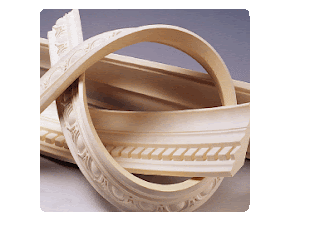

Have you ever wanted to put crown molding around an arched doorway or a curved wall in one of your rooms, but couldn’t find anything to use, so you gave up? Well, you might have given up too early. Flexible molding was designed for just such projects. Flexible molding makes it a cinch to decorate around curved walls and arched doorways and windows.
Flexible molding is made from a compound polymer resin that has been engineered to bend or curve around more challenging shapes. It can be bent or twisted without breaking or splintering. Flexible molding can actually be purchased in a range of grades, from very flexible to totally rigid.
You can find flexible molding in just about any design and type you can imagine. Chair rails, baseboards, cornice, window casements, and crown, are all available for your decorative needs. Keep in mind, though, that you really only want to use flexible molding where it is essential to your home improvement project, as it does cost much more than wood millwork.
One of the best features of flexible molding is it's superiority to wood. Flexible molding can be stained, painted, or sealed just as ordinary molding, but without having to prime the surface first. It also resists warping, wearing, splitting, or mildewing, so it's great for outdoor use as well.
Flexible molding conforms to any radius and it is easily installed. The cost of labor is kept down by eliminating standard procedures, such as steaming or cut-n-fill, that would usually be required when decorating rounded walls and columns.
Another great advantage of flexible millwork products is that they look just like real wood. They can be painted, cut, sawed, drilled or shaped just like real wood products. You can use flexible molding on any radius or curved treatment where wood can not be used.
Advantages of Flexible Molding
The advantages and uses for flexible molding are numerous and allow the homeowner to modernize their home in new and original design conceptions. Here is a brief recap of the advantages of flexible molding:
• It looks like real wood.
• It is durable so it can also be used exteriorly
• It’s flexibility is a major advantage
• It resists moisture
• It is insect resistant
• It can be finished like wood
• It can be painted like wood
• It can be found in a variety of designs
• It can be routed, cut, sawed or shaped like wood
• Flexible molding is not affected by heat, cold, moisture or salt
• It can be painted, sanded, or stained
• It can be drilled, nailed, or glued
• It is easily installed
GoCeilingMedallion.com offers several brands of flexible molding from our manufacturers. These moldings offer an incredible labor savings when your decorative molding installations necessitate a curved or arched product. They can be custom ordered from a wide collection of crown, cornice, chair rail, frieze, and panel moldings.
Most moldings can be ordered in incremental lengths from 4 feet to 12 feet and you can order any combination of these lengths for your application.
Some general recommendations for both types of flexible molding address surface preparation and pre-installation groundwork.
Before Installation:
• You may choose to finish (paint or faux finish) the molding before installation
• You should place the molding in the room for 48 to 72 hours before installing in order to allow the molding to adjust to the temperature and humidity levels of the room
• ALWAYS store molding in a dry, well-ventilated, low-humidity area
• NEVER store your molding outdoors.
Surface Preparation:
• Clean all surfaces free of dirt and loose particles with a clean cloth or sponge
• Make sure the area is completely dry before installing.
The photos above give you some idea of the flexibility and advantages of flexible molding. Anywhere you can imagine using flexible molding or any style that you desire are possible to afford you the capability to design the home of your dreams. Give GoCeilingMedallion.com a call with your custom order today.